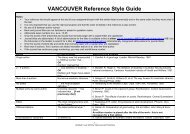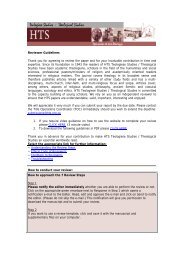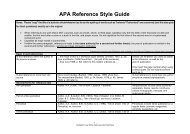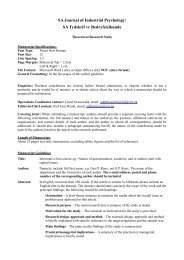Quantitative Research
Quantitative Research
Quantitative Research
Create successful ePaper yourself
Turn your PDF publications into a flip-book with our unique Google optimized e-Paper software.
Key words:<br />
Synopsis:<br />
· Contribution/value-add – A concluding statement indicates the contribution or valueadd<br />
of the study in addressing gaps or contradictions in the literature.<br />
Use five [5] words not already included in the title, separated by a semi-colon. Refer to the<br />
discipline; sub-discipline; field; theme; research design; context<br />
Afrikaans articles (or articles in any other official SA language) must also have a synopsis of<br />
the article of between 500-600 words in English (the entire synopsis appears in italics).<br />
We also ask that you upload a brief biographical note (entered into the ‘Bio statement’ box during the<br />
submission process). This note will appear online in our ‘About the Author’ section should your article be<br />
published with us.<br />
Manuscript Contents<br />
The manuscript contains five sections, namely the introduction, research design, results, discussion and the<br />
references. All these first-level headings appear in bold capital letters and are centered.<br />
INTRODUCTION:<br />
The introductory section normally contains the following seven elements; headings are indicated in<br />
[brackets]:<br />
Tips on Introduction Section:<br />
(1) [Key focus of the study] A thought-provoking introductory statement on the broad<br />
theme or topic of the research (why should I even bother to read further);<br />
(2) [Background to the study] Providing the background or the context to the study<br />
(explaining the role of other relevant key variables in this study);<br />
(3) [Trends from the research literature] Cite the most important published studies<br />
previously conducted on this topic or that has any relevance to this study (provide a<br />
high-level synopsis of the research literature on this topic);<br />
(4) [<strong>Research</strong> Objectives] Indicate the most important controversies, gaps and<br />
inconsistencies in the literature that will be addressed by this study;<br />
(5) In view of the above (in 4) state the core research problem and specific research<br />
objectives that will be addressed in this study;<br />
(6) [The potential value-add of the study] Explanation of the study’s academic<br />
(theoretical & methodological) or practical merit and/or importance (provide the<br />
value-add and/or rationale for the study); and<br />
(7) [What will follow] Provide the reader with an outline of what to expect in the rest of<br />
the article.<br />
The first-level heading is INTRODUCTION. However, second-level headings may be used in this<br />
introductory section. These subheadings are flush with the margin, and are typed in lower case; bold starting<br />
with a capital letter. The INTRODUCTION section consists of an introduction to the article and a literature<br />
review.<br />
If lists of bullet points are presented, they should be in the following format:<br />
• Longevity. How long individuals live.<br />
• Prognosis. How well an individual responds to challenges of disease or trauma.<br />
• Mental health. General level of mental functioning<br />
Avoid using lists that contain more than 10 bullet points.




![Reference Style Guide [17-09-2008 Tdv].pdf](https://img.yumpu.com/42195443/1/184x260/reference-style-guide-17-09-2008-tdvpdf.jpg?quality=85)



